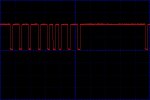Andrew Cowan
Senior Member
I'm working on a radio project, that requires me to generate a PPM pulse stream with the following timing requirements:
400uS Synch pulse
600-1600uS pulse for channel 1
400uS Synch pulse
600-1600uS pulse for channel 2
400uS Synch pulse
600-1600uS pulse for channel 3
400uS Synch pulse
600-1600uS pulse for channel 4
400uS Synch pulse
600-1600uS pulse for channel 5
400uS Synch pulse
600-1600uS pulse for channel 6
400uS Synch pulse
600-1600uS pulse for channel 7
400uS Synch pulse
600-1600uS pulse for channel 8
400uS Synch pulse
Read 4 potentiometers
Repeat sequence.
This al needs to run in a 22mS cycle - so a worst case of 5.6mS to read the potentiometers.
For an 18M2 running at 32MHz, using pulseout, this all looks easily acheiveable - can anyone see any problems/issues I might come accross?
Thanks
Andrew
400uS Synch pulse
600-1600uS pulse for channel 1
400uS Synch pulse
600-1600uS pulse for channel 2
400uS Synch pulse
600-1600uS pulse for channel 3
400uS Synch pulse
600-1600uS pulse for channel 4
400uS Synch pulse
600-1600uS pulse for channel 5
400uS Synch pulse
600-1600uS pulse for channel 6
400uS Synch pulse
600-1600uS pulse for channel 7
400uS Synch pulse
600-1600uS pulse for channel 8
400uS Synch pulse
Read 4 potentiometers
Repeat sequence.
This al needs to run in a 22mS cycle - so a worst case of 5.6mS to read the potentiometers.
For an 18M2 running at 32MHz, using pulseout, this all looks easily acheiveable - can anyone see any problems/issues I might come accross?
Thanks
Andrew


